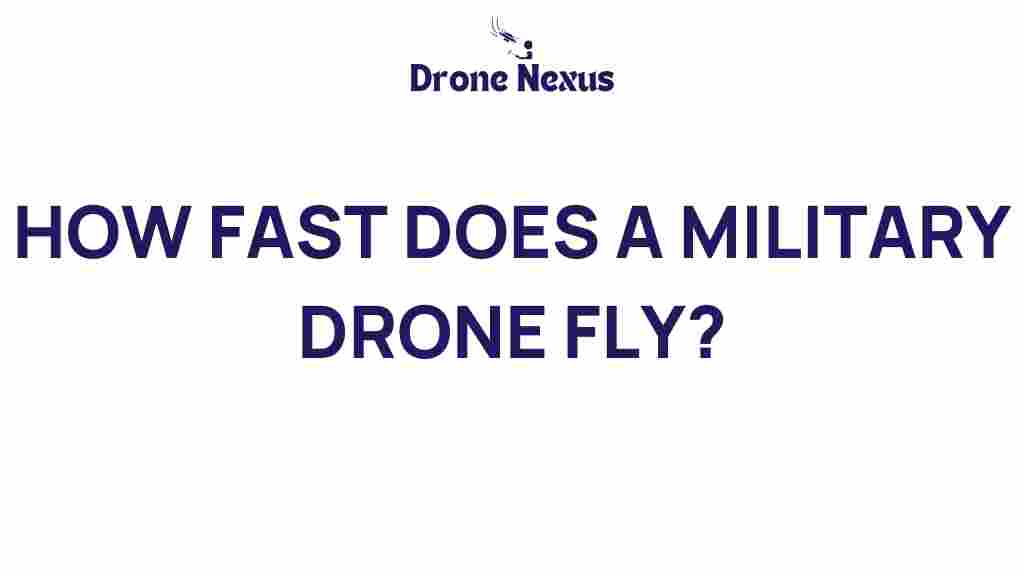Understanding Military Drones: How Fast Do Military Drones Really Fly?
Military drones have revolutionized modern warfare, providing unprecedented surveillance capabilities and precision strike options. As technology advances, one of the most frequently asked questions regarding these unmanned aerial vehicles (UAVs) is their speed. Understanding how fast military drones fly not only showcases their capabilities but also emphasizes their role in strategic operations. In this article, we will delve into various types of military drones, their speeds, and what factors influence those speeds.
Types of Military Drones
Before we explore the speeds of military drones, it’s important to recognize the different categories they fall into. Each type serves a unique purpose and comes with its own specifications:
- Reconnaissance Drones: These drones are primarily used for surveillance and intelligence gathering. Examples include the MQ-1 Predator and the RQ-4 Global Hawk.
- Combat Drones: Designed for strike missions, combat drones like the MQ-9 Reaper can carry weaponry and engage targets.
- Transport Drones: These drones are used for logistics and supply missions, transporting cargo to remote locations.
- Swarm Drones: A newer concept, swarm drones work together to overwhelm enemy defenses through coordinated attacks.
How Fast Do Military Drones Fly?
The speed of military drones can vary significantly based on their type and intended use. Here’s a breakdown of the speeds associated with various drones:
- MQ-1 Predator: This reconnaissance drone has a maximum speed of around 135 knots (approximately 155 mph).
- MQ-9 Reaper: A more advanced combat drone, the Reaper can reach speeds of up to 230 knots (about 265 mph).
- RQ-4 Global Hawk: Designed for high-altitude surveillance, the Global Hawk can fly at speeds of around 300 knots (approximately 345 mph).
- Lockheed Martin RQ-170 Sentinel: This stealth drone can achieve speeds of up to 350 knots (around 403 mph).
- Northrop Grumman X-47B: As a prototype for carrier-based operations, it has a top speed of 400 knots (about 460 mph).
Factors Influencing Drone Speed
Several key factors can affect the speed capabilities of military drones:
- Design and Size: Larger drones typically have more powerful engines, allowing for greater speeds. Conversely, smaller drones may prioritize stealth and maneuverability over speed.
- Mission Type: Drones designed for reconnaissance may prioritize endurance and altitude over speed, while combat drones may be optimized for rapid engagement.
- Weather Conditions: Wind and atmospheric conditions can significantly impact the actual flying speed of a drone. Drones may struggle against strong headwinds or benefit from tailwinds.
- Payload Weight: The weight of the equipment or armaments carried by a drone can also affect its speed and performance. Heavier payloads can slow down the drone.
Speed Comparison: Military vs. Commercial Drones
It’s also useful to compare military drones with their commercial counterparts. While commercial drones generally prioritize user-friendliness, military drones are engineered for performance. Here’s how they stack up:
- Commercial Drones: Most commercial drones, like the DJI Phantom series, have speeds ranging from 15 to 50 mph, which is significantly slower than military drones.
- Military Drones: As mentioned, military drones like the MQ-9 Reaper can reach speeds of over 200 mph, making them much faster than civilian models.
Step-by-Step Process: Understanding Military Drone Operations
To further appreciate how military drones operate, let’s break down the typical steps involved in a drone mission:
- Mission Planning: Military operations begin with extensive planning, where objectives are outlined, and the appropriate drone type is selected based on mission requirements.
- Pre-Flight Checks: Before takeoff, thorough checks are conducted on the drone’s systems, payload, and fuel levels to ensure everything is operational.
- Launch and Initial Climb: The drone is launched, often from a remote location, and ascends to its designated altitude, optimizing speed and fuel efficiency.
- Data Collection: During the mission, drones collect data through various sensors, whether for reconnaissance or targeting purposes.
- Engagement (if applicable): If the mission involves combat, the drone may engage targets using onboard weaponry.
- Return to Base: After completing its objectives, the drone returns to its base for recovery, often following a pre-planned route.
Troubleshooting Tips for Military Drone Operations
Military drone operations can face challenges that may affect their speed and performance. Here are some common troubleshooting tips:
- Connectivity Issues: Ensure that communication systems are functioning correctly. Check for any interference that may disrupt signals.
- Flight Path Optimization: Analyze the pre-planned flight path for any obstacles or changes in terrain that may hinder speed.
- Payload Management: Regularly assess payload weight and distribution to avoid affecting performance. Consider reducing payloads if speed is a critical factor.
- Weather Monitoring: Keep a close eye on weather conditions. Adjust flight plans accordingly to mitigate the effects of adverse weather.
Conclusion
Understanding the speeds of military drones reveals their crucial role in modern warfare. From surveillance to combat, the speed of these UAVs is a testament to their engineering and design. Military drones, which can reach impressive speeds ranging from 135 mph to over 400 mph, significantly outperform commercial drones. Factors such as design, mission type, and weather conditions all play vital roles in determining their capabilities. As technology continues to evolve, we can expect military drones to become even faster and more efficient, further enhancing their strategic importance in defense operations.
For more insights into military technology, check out this link. To stay updated on the latest drone advancements, visit this external resource.
This article is in the category Technology and created by DroneNexus Team
